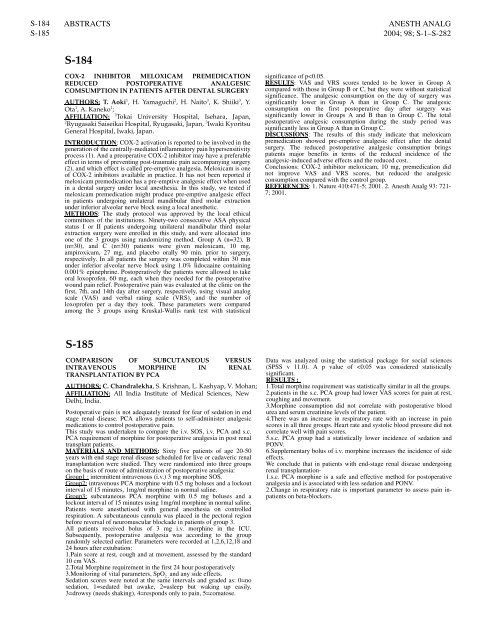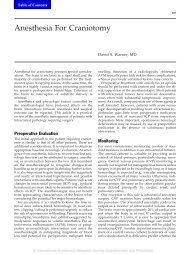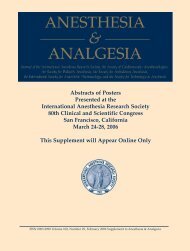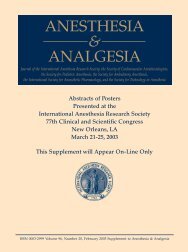ANESTHESIA & ANALGESIA - IARS
ANESTHESIA & ANALGESIA - IARS
ANESTHESIA & ANALGESIA - IARS
Create successful ePaper yourself
Turn your PDF publications into a flip-book with our unique Google optimized e-Paper software.
S-184<br />
S-185<br />
ABSTRACTS ANESTH ANALG<br />
2004; 98; S-1–S-282<br />
S-184<br />
COX-2 INHIBITOR MELOXICAM PREMEDICATION<br />
REDUCED POSTOPERATIVE ANALGESIC<br />
COMSUMPTION IN PATIENTS AFTER DENTAL SURGERY<br />
AUTHORS: T. Aoki 1 , H. Yamaguchi 2 , H. Naito 3 , K. Shiiki 3 , Y.<br />
Ota 1 , A. Kaneko 1 ;<br />
AFFILIATION: 1 Tokai University Hospital, Isehara, Japan,<br />
2 3<br />
Ryugasaki Saiseikai Hospital, Ryugasaki, Japan, Iwaki Kyoritsu<br />
General Hospital, Iwaki, Japan.<br />
INTRODUCTION: COX-2 activation is reported to be involved in the<br />
generation of the centrally-mediated inflammatory pain hypersensitivity<br />
process (1). And a preoperative COX-2 inhibitor may have a preferable<br />
effect in terms of preventing post-traumatic pain accompanying surgery<br />
(2), and which effect is called pre-emptive analgesia. Meloxicam is one<br />
of COX-2 inhibitors available in practice. It has not been reported if<br />
meloxicam premedication has a pre-emptive analgesic effect when used<br />
in a dental surgery under local anesthesia. In this study, we tested if<br />
meloxicam premedication might produce pre-emptive analgesic effect<br />
in patients undergoing unilateral mandibular third molar extraction<br />
under inferior alveolar nerve block using a local anesthetic.<br />
METHODS: The study protocol was approved by the local ethical<br />
committees of the institutions. Ninety-two consecutive ASA physical<br />
status I or II patients undergoing unilateral mandibular third molar<br />
extraction surgery were enrolled in this study, and were allocated into<br />
one of the 3 groups using randomizing method. Group A (n=32), B<br />
(n=30), and C (n=30) patients were given meloxicam, 10 mg,<br />
ampiroxicam, 27 mg, and placebo orally 90 min. prior to surgery,<br />
respectively. In all patients the surgery was completed within 30 min<br />
under inferior alveolar nerve block using 1.0% lidocaaine containing<br />
0.001% epinephrine. Postoperatively the patients were allowed to take<br />
oral loxoprofen, 60 mg, each when they needed for the postoperative<br />
wound pain relief. Postoperative pain was evaluated at the clinic on the<br />
first, 7th, and 14th day after surgery, respectively, using visual analog<br />
scale (VAS) and verbal rating scale (VRS), and the number of<br />
loxoprofen per a day they took. These parameters were compared<br />
among the 3 groups using Kruskal-Wallis rank test with statistical<br />
S-185<br />
COMPARISON OF SUBCUTANEOUS VERSUS<br />
INTRAVENOUS MORPHINE IN RENAL<br />
TRANSPLANTATION BY PCA<br />
AUTHORS: C. Chandralekha, S. Krishnan, L. Kashyap, V. Mohan;<br />
AFFILIATION: All India Institute of Medical Sciences, New<br />
Delhi, India.<br />
Postoperative pain is not adequately treated for fear of sedation in end<br />
stage renal disease. PCA allows patients to self-administer analgesic<br />
medications to control postoperative pain.<br />
This study was undertaken to compare the i.v. SOS, i.v. PCA and s.c.<br />
PCA requirement of morphine for postoperative analgesia in post renal<br />
transplant patients.<br />
MATERIALS AND METHODS: Sixty five patients of age 20-50<br />
years with end stage renal disease scheduled for live or cadaveric renal<br />
transplantation were studied. They were randomized into three groups<br />
on the basis of route of administration of postoperative analgesia:<br />
Group1 : intermittent intravenous (i.v.) 3 mg morphine SOS.<br />
Group2: intravenous PCA morphine with 0.5 mg boluses and a lockout<br />
interval of 15 minutes, 1mg/ml morphine in normal saline.<br />
Group3: subcutaneous PCA morphine with 0.5 mg boluses and a<br />
lockout interval of 15 minutes using 1mg/ml morphine in normal saline.<br />
Patients were anesthetised with general anesthesia on controlled<br />
respiration. A subcutaneous cannula was placed in the pectoral region<br />
before reversal of neuromuscular blockade in patients of group 3.<br />
All patients received bolus of 3 mg i.v. morphine in the ICU.<br />
Subsequently, postoperative analgesia was according to the group<br />
randomly selected earlier. Parameters were recorded at 1,2,6,12,18 and<br />
24 hours after extubation:<br />
1.Pain score at rest, cough and at movement, assessed by the standard<br />
10 cm VAS.<br />
2.Total Morphine requirement in the first 24 hour postoperatively<br />
3.Monitoring of vital parameters, SpO2 , and any side effects.<br />
Sedation scores were noted at the same intervals and graded as: 0=no<br />
sedation, 1=sedated but awake, 2=asleep but waking up easily,<br />
3=drowsy (needs shaking), 4=responds only to pain, 5=comatose.<br />
significance of p





